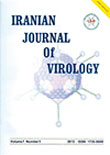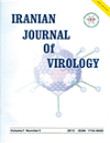فهرست مطالب

Iranian Journal of Virology
Volume:9 Issue: 1, 2015
- تاریخ انتشار: 1393/11/20
- تعداد عناوین: 6
-
-
Pages 1-6vaccines is considered as a critical point and in-process of quality control (IPQC) test of vaccine production. Rapid tests, like real time PCR, are more appropriated when the production occurs at industrial scale because of the amounts of starting materials and the excess of consumed time required. In the current study, a real-time quantitative reverse transcription-polymerase chain reaction (qRT-PCR) was developed for Rubella virus (RV) and tested on a commercially available MMR vaccine.Materials And MethodsThe primers and Taq Man probe were designed by Gene runner version 5.0.63 software. Concentrations, as well as reaction temperatures were optimized to establish an efficient qRT-PCR assay for RV RNA. A RV-specific PCR amplicon (109 bp), conserved in all species, was made as an external standard to evaluate the linearity, amplification efficiency, analytical sensitivity and reproducibility of the qRT-PCR.ResultsThe real time quantitative assay was shown to have good linearity (R2=0.998), high amplification efficiency (E=96.18%), and high sensitivity (7 × 10 2 copies / 7 µl) for tested vaccine.ConclusionThe established qRT-PCR method is a simple, rapid, quantitative, highly specific and sensitive assay for quantification of RV RNA copy numbers in IPQC tests at industrial scale.Keywords: Rubella Virus, MMR Vaccine, Quantitative Real, Time reverse transcription, polymerase chain reaction
-
Pages 7-12Background And AimsInfectious laryngotracheitis virus (ILTV) infection causes a highly contagious respiratory disease in poultry leads to significant economic losses in the poultry industry. The genomic and antigenic characteristics between virulent and vaccine strains of ILTV are very similar. The ability of embryonated chicken neural stem (CNS) cell for differential diagnosis of ILTV strains was also evaluated.Materials And MethodsCNS cell cultures were inoculated with an ILTV vaccine stain and a virulent strain at different viral multiplicity of infections (MOI). The replication and growth kinetics of the viruses were evaluated by estimation of suitable time of infection, production of virus infectivity titers, and amplification of ICP4 gene in collected samples.ResultsBased on PCR and virus titration assays, the ILTV strains were able to enter CNS cells and replicate efficiently at all MOIs used. The virus titers and tracing of ICP4 data were found to be similar, but marked cytopathic effect (CPE) was only detected in ILTV vaccine stain infection as compared to virulent strain.ConclusionThe neural stem cell had a higher growth potential and infectivity of ILTV strains, which will be of advantage in differential diagnosis.Keywords: Infectious laryngotracheitis virus, embryonic chicken neural stem cell, Replication kinetic, cytopathic effect
-
Pages 13-20Background And AimsThe human papilloma virus was introduced as the major etiological agent in outbreak of cervical cancer in 1970. Since it is impossible to recognize these viruses and these types using the serological tests and cell culture, molecular methods such as PCR are of great importance. Therefore, in this study, our goal was to use a multiple specific PCR assay on L1 and E6 genes of HPV for molecular detection of this virus and its common types detection in the society.Materials And MethodsAfter collecting the samples from malignant lesions of various patients, the viral DNA were extracted from paraffin blocks of 50 clinical samples and the PCR method was performed on the mentioned samples by specific primers for L1 and E6 genes together with β-globin (as internal control). The PCR product was analyzed on 2℅ agarose gel and the sensitivity of this test was examined.Resultsfrom among 50 samples of the patients, 33 cases were HPV positive and 17 ones were negative. The sensitivity of this test was 20 copies from recombinant construct containing target genes for each reaction.Conclusionthis study confirmed that the designed PCR with specific primers on L1 and E6 genes of HPV proved to be an accurate method for detecting and determining the HPV types.Keywords: Cancer of cervix, Human Papilloma Virus, PCR
-
Pages 21-25Avian infectious bronchitis (IB) is a widely distributed poultry disease that has huge economic impact on poultry industry. The continuous emergence of new IBV genotypes and lack of cross protection among different IBV genotypes have been an important challenge. The present study was done to evaluate protection caused by two different serotypes vaccines (Massachusetts & 793/B) in order to evaluate protection against challenge with Iranian QX like-virus. The results showed a protective ability of the used vaccination program. The H120-793/B vaccinated group obtained 81% protection. These results indicate that the H120 793/B vaccines could be helpful for the reduction of economic losses caused by newly evolving QX IBV variants.Keywords: Avian infectious bronchitis, Vaccination, Cross protection, 793, B
-
Diagnostic and epidemiologic features of hepatitis C among hemodialysis patients living in Yazd province of IranPages 26-31Background And AimsHepatitis C is a blood-borne virus that cause a liver inflammation. The prevalence of hepatitis C (HCV) in hemodialysis patients is more than the general population. Periodic screening of HCV in dialysis centers is necessary for control this viral disease. The aim of this study is the evaluation of HCV infection among hemodialysis patients living in Yazd province of Iran.Materials And MethodsIn this cross sectional study, two milliliters blood sample has been taken from each of 188 hemodialysis patients. Third-generation enzyme-linked immunosorbent assay (ELISA) and RT-PCR methods were carried out for detecting HCV antibody and viral genome in patient sera. Demographic and clinical characteristics of patients were collected and data were analyzed by Fisher's exact test and MannWhitney U test in SPSS software v.19.ResultsHCV-Ab was positive in 12 hemodialysis patients. Eight cases had history of blood transfusion and four patients had a history of kidney transplantation. Anyone didnt have a history of skin tattooing or intravenous drug usage. HCV-RNA was positive in 4 cases and was negative in 8 patients with positive HCV-Ab.ConclusionHCV prevalence using ELISA and RT-PCR tests among hemodialysis patients living in Yazd provenance of Iran is 6.3% and 2.1%, respectively. Risk factors are hemodialysis duration (pKeywords: Enzyme, Linked Immunosorbent Assay, Hepatitis C, Renal Dialysis
-
Pages 32-35Apple scar skin disease (ASSD) is one of the destructive diseases of pome fruits which is caused by ASSVd. We report molecular detection of ASSVd in symptomatic apples cv. Red Delicious with simultaneous presence of a new variant of HSVd from Khorasan Razavi province. This is the first report on the association of HSVd with ASSVd in apple trees showing merely symptoms of apple dapple on the fruit.Keywords: Apple, Viroid, Hop stunt, Khorasan


